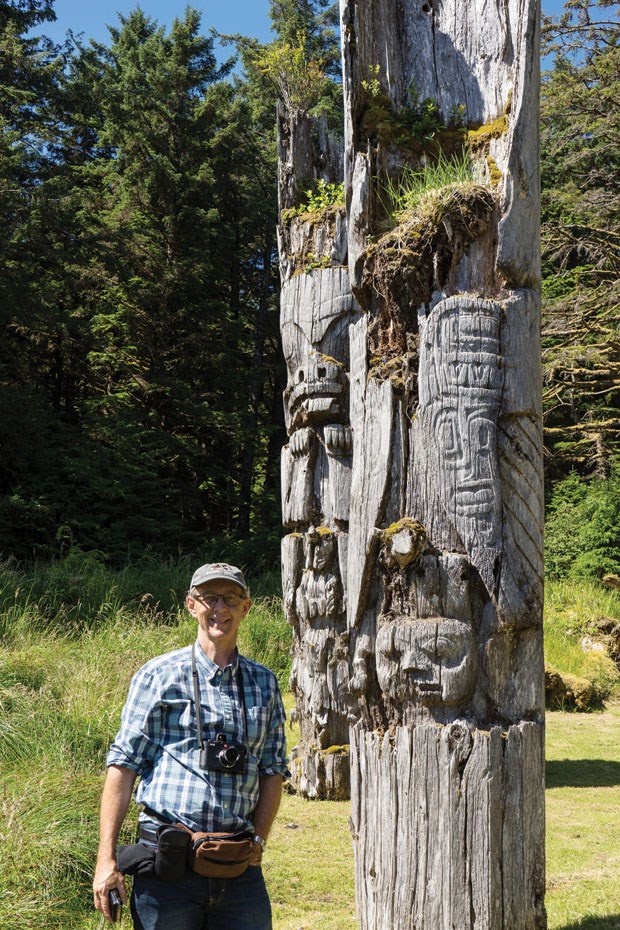They are silent sentinels standing above the shoreline.
Leaning, crumbling and decaying poles, carved more than 100 years ago. Blank eyes still stare out to sea and their symbolism reaches across the ages in a mystical way.
After decades of talking about visiting Haida Gwaii, a remote archipelago off the northern coast of B.C., Gary and I are finally standing amongst the poles at one of the most sacred sites in these islands, SGang Gwaay Llnagaay.
Our day begins at the float plane dock in Queen Charlotte City. Pete, the pilot, piles us into his 1950s Beaver and smoothly skims across the harbour for takeoff. During the 90-minute flight over green forested hills and brilliant blue waters, he gives us a short course on island geography, legends, history, landmarks and fauna.
We learn there is a subspecies of black bear with for eating seafood but not cougars.
He regales us with tales of abandoned villages, logging practices, protests with road blockades and hot spring pools temporarily dried up by an earthquake.
The southern part of Haida Gwaii is the first area worldwide to be protected from mountain top to sea bed and is known as the Gwaii Haanas National Park Reserve, National Marine Conservation Area and Haida Heritage Site. Ancient SGang Gwaay, one of the best examples of a traditional coastal First Nations village site, is on the UNESCO World Heritage list.
Pete lands the plane at Rose Harbour and we clamber from the plane to the Rubber Duck zodiac captained by Patrick, a French Canadian with a very dry sense of humour. After awkwardly pulling on orange survival suits that make us look as padded as the Michelin Man, we hang on tightly for a sprayfilled, bouncy half-hour ride to Anthony Island.
From where Patrick lands the zodiac, a boardwalk winds through the woods. The temperate rain forest is lush, with towering trees, spongy moss and tangled undergrowth. Its rich, humid smell mingles with the brisk ocean breeze and feels like it cleans my lungs as I breathe.
At the end of the boardwalk we meet Ken, our Haida watchman. Through the summer, watchmen live at the ancient sites in Gwaii Haanas, acting as guardians of the natural and cultural heritage and interpreting the history for visitors. We follow him along a winding path to the village site. It was one of the largest Haida villages and had been occupied for likely 2,000 years or more.
The first glimpse of the row of poles makes us stop and stare. They are carved of western red cedar, ideal for the purpose with its straight grain and soft wood. Some are tall memorials, commemorating an ancestor lost at sea, but most are mortuary poles.
Mossy logs and a few timbers mark the outlines of where houses stood, of which there were about 20. Ken elaborates on how the post-and-beam houses were constructed. I stand on the beach and imagine how attractive the village must have looked with its row of mortuary poles fronting a line of cedar houses, each with a frontal pole; all backed by the verdant forest.
All too soon, we wend our way back onto the Rubber Duck and zip away from the Wailing Island. Before we reach Rose Harbour, we spot a pair of humpback whales and Gary is lucky enough to see one breach.
After Pete pumps water out one of the plane's pontoons while reassuring us, we are back in the sky. As I gaze at the scenery and reflect upon the power and peacefulness of SGang Gwaay, all I can say is haaw'a (thank you), Haida Gwaii.
Travel Writers' Tales is an independent newspaper syndicate that offers professionally written travel articles to newspaper editors and publishers. To check out more, visit www.travelwriterstales.com.



